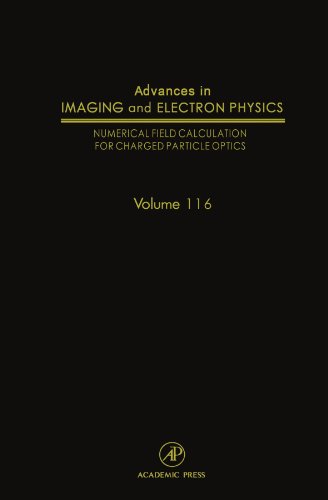

Most ebook files are in PDF format, so you can easily read them using various software such as Foxit Reader or directly on the Google Chrome browser.
Some ebook files are released by publishers in other formats such as .awz, .mobi, .epub, .fb2, etc. You may need to install specific software to read these formats on mobile/PC, such as Calibre.
Please read the tutorial at this link: https://ebookbell.com/faq
We offer FREE conversion to the popular formats you request; however, this may take some time. Therefore, right after payment, please email us, and we will try to provide the service as quickly as possible.
For some exceptional file formats or broken links (if any), please refrain from opening any disputes. Instead, email us first, and we will try to assist within a maximum of 6 hours.
EbookBell Team

5.0
20 reviews
ISBN 10: 0120147580
ISBN 13: 9780120147588
Author: Peter W Hawkes
Chapter 1: Introduction to Charged Particle Optics
1.1 What are Charged Particle Optics?
1.2 Applications of Charged Particle Optics
1.2.1 Electron Microscopes (SEM, TEM)
1.2.2 Mass Spectrometry
1.2.3 Particle Accelerators
1.2.4 Ion Implantation
1.3 The Need for Numerical Field Calculation
1.4 Overview of the Book
Chapter 2: Mathematical and Physical Foundations
2.1 Maxwell's Equations and Electrostatics
2.1.1 Gauss's Law and Electrostatic Potential
2.1.2 Poisson's Equation and Laplace's Equation
2.2 Magnetic Fields and Magnetostatics
2.2.1 Ampere's Law
2.2.2 The Biot-Savart Law
2.3 Lorentz Force and Particle Trajectories
2.4 Boundary Conditions
2.4.1 Dirichlet Boundary Conditions
2.4.2 Neumann Boundary Conditions
2.4.3 Mixed Boundary Conditions
2.5 Discretization and Grids
Chapter 3: Numerical Methods for Electrostatic Field Calculation
3.1 The Finite Difference Method (FDM)
3.1.1 Discretization of the Laplace and Poisson Equations
3.1.2 Finite Difference Stencils (5-point, 9-point)
3.1.3 Handling Irregular Boundaries
3.2 The Finite Element Method (FEM)
3.2.1 Variational Formulation
3.2.2 Shape Functions and Element Types (Triangles, Quadrilaterals)
3.2.3 Assembly of the Global Stiffness Matrix
3.3 The Boundary Element Method (BEM)
3.3.1 Green's Functions and Integral Equations
3.3.2 Advantages and Disadvantages of BEM
3.4 Comparison of Numerical Methods (FDM, FEM, BEM)
Chapter 4: Numerical Methods for Magnetostatic Field Calculation
4.1 The Vector Potential (A)
4.2 Finite Difference Method for Magnetostatics
4.3 Finite Element Method for Magnetostatics
4.3.1 Formulation using the Vector Potential
4.3.2 Handling Iron and Ferromagnetic Materials
4.4 The Biot-Savart Law for Coil Geometries
4.5 Special Considerations for Symmetries (Axisymmetry)
Chapter 5: Relativistic Effects and Space Charge
5.1 Relativistic Equations of Motion
5.2 Space Charge Effects and the Poisson-Vlasov Equation
5.3 Iterative Methods for Space Charge (PIC - Particle-in-Cell)
5.3.1 Charge Assignment
5.3.2 Field Calculation
5.3.3 Particle Pushing
5.3.4 Interpolation
Chapter 6: Particle Trajectory Calculation
6.1 Equations of Motion and the Lorentz Force
6.2 Numerical Integration Methods
6.2.1 Euler Method
6.2.2 Runge-Kutta Methods (RK4)
6.2.3 Symplectic Integrators
6.3 Ray Tracing and Beam Envelopes
Chapter 7: Practical Implementation and Software
7.1 Pre-processing: Geometry and Mesh Generation
7.2 Solving Linear Systems of Equations
7.2.1 Direct Solvers (LU decomposition)
7.2.2 Iterative Solvers (Jacobi, Gauss-Seidel, Conjugate Gradient)
7.3 Post-processing: Field and Trajectory Visualization
7.4 Commercial and Open-Source Software for Charged Particle Optics (e.g., SIMION, COMSOL, Warp, GPT)
Chapter 8: Advanced Topics and Case Studies
8.1 Aberrations in Charged Particle Lenses
8.2 Time-Varying Fields (RF cavities)
8.3 Applications in specific devices (e.g., Electron Gun, Quadrupole Lens)
8.4 Optimization of Electrode and Coil Shapes
numerical field calculation
numeric field
numeric field example
numeric field sql
numeric field types
Tags: Peter W Hawkes, Numerical, Calculation